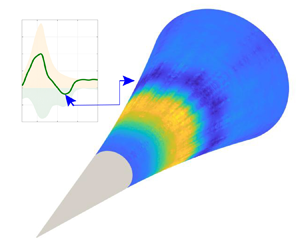Article contents
Dilatational-wave-induced aerodynamic cooling in transitional hypersonic boundary layers
Published online by Cambridge University Press: 29 January 2021
Abstract

The evolution of an instability in a transitional hypersonic boundary layer and its effects on aerodynamic cooling are investigated over 260-mm-long flared cone models with smooth and porous surfaces. Experiments are conducted in a Mach 6 wind tunnel using Rayleigh-scattering flow visualization, fast-response pressure sensors and an infrared camera. Calculations are performed based on both direct numerical simulations (DNS) and linear stability theory (LST). The unit Reynolds number is  $9.7 \times 10^6\ \textrm {m}^{-1}$. It is confirmed that a cooled region appears downstream of the local heat peak as the second-mode instability evolves over the smooth-surface model, as found in other studies. Comparisons between the DNS and LST results show that the nonlinear interaction of the second mode causes the phase difference
$9.7 \times 10^6\ \textrm {m}^{-1}$. It is confirmed that a cooled region appears downstream of the local heat peak as the second-mode instability evolves over the smooth-surface model, as found in other studies. Comparisons between the DNS and LST results show that the nonlinear interaction of the second mode causes the phase difference  $\phi _{p\theta }$ to change between the periodic pressure and dilatation waves. This forms a negative cycle-averaged pressure dilatation near the wall and creates the cooled region. Further, by using porous steel to modify the sound admittance of the model surface, it is possible to artificially obtain negative cycle-averaged pressure dilatation near the wall, and thus reduce the surface heat flux by approximately 28 %. These results indicate the possibility of precisely controlling the pressure-dilatation-induced aerodynamic heating through the modification of surface sound admittance.
$\phi _{p\theta }$ to change between the periodic pressure and dilatation waves. This forms a negative cycle-averaged pressure dilatation near the wall and creates the cooled region. Further, by using porous steel to modify the sound admittance of the model surface, it is possible to artificially obtain negative cycle-averaged pressure dilatation near the wall, and thus reduce the surface heat flux by approximately 28 %. These results indicate the possibility of precisely controlling the pressure-dilatation-induced aerodynamic heating through the modification of surface sound admittance.
- Type
- JFM Papers
- Information
- Copyright
- © The Author(s), 2021. Published by Cambridge University Press
References
REFERENCES
Zhu et al. supplementary movie 1
Time variation in Temperature and Temperature growth ratio after the hypersonic wind tunnel starts, arising from IR camera measurement.
- 18
- Cited by





